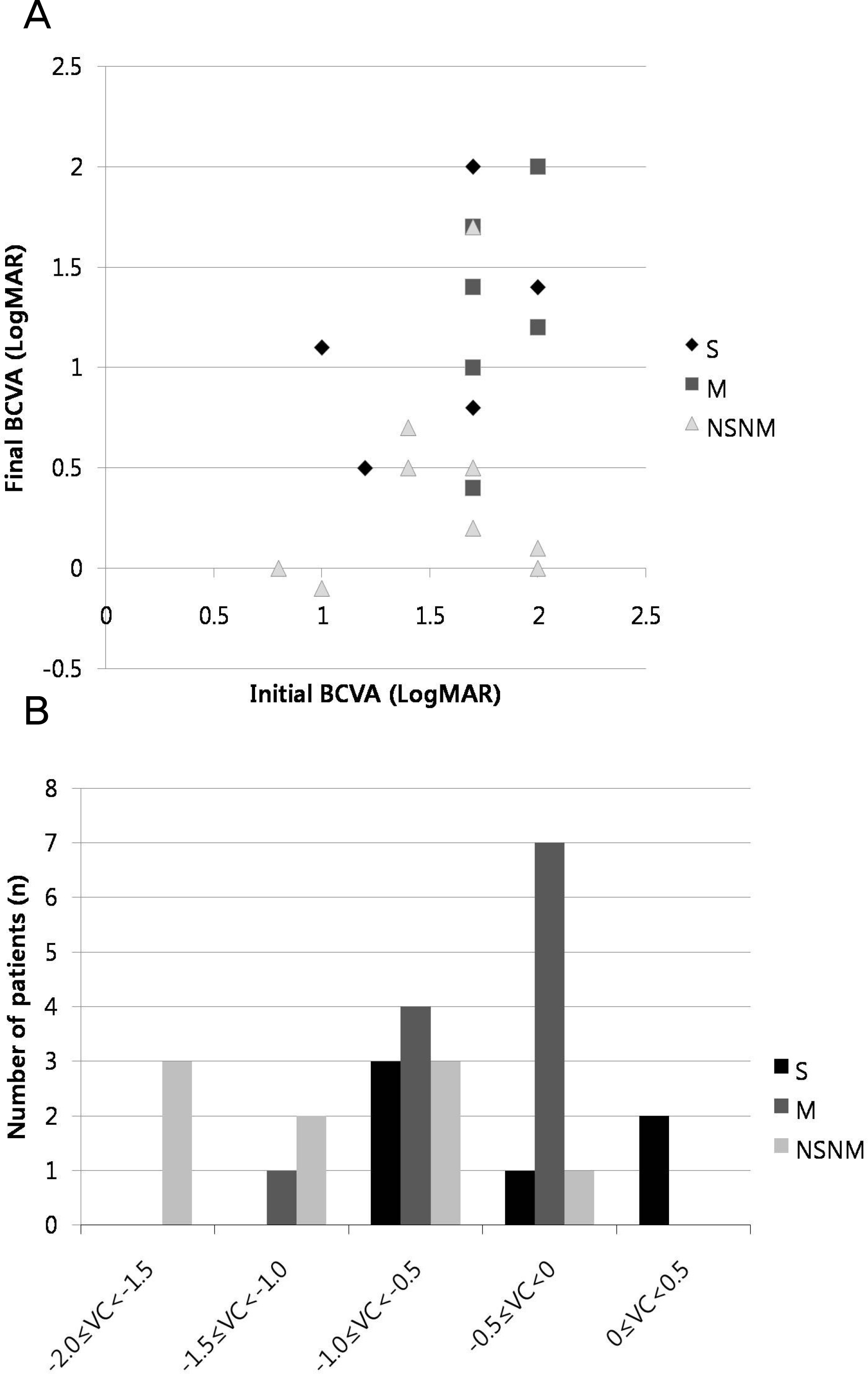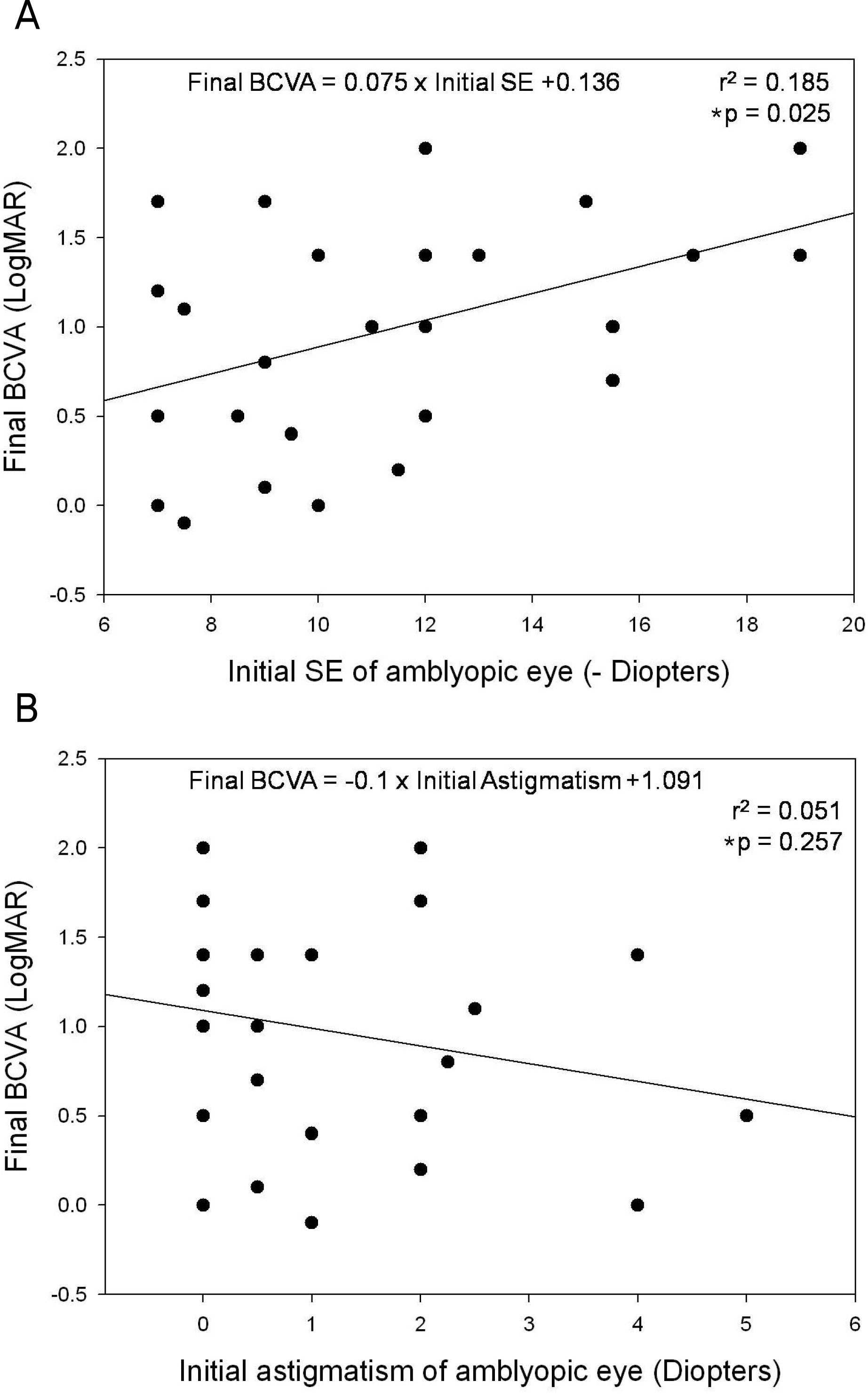Abstract
Purpose
To report the clinical outcome of children with unilateral high myopic anisometropic amblyopia who were treated with contact lenses (CL).
Methods
Patients who had myopic anisometropia greater than −7 diopters and was treated with contact lenses combined with occlusion therapy during the period between 1998 and 2007 were retrospectively reviewed. Twenty-seven patients who were followed up for more than 1 year after treatment were included in the study. Initial and final best corrected visual acuities (BCVA) were compared and factors which influence the visual outcome were analyzed.
Results
A total of 10 out of 27 patients (37%) acquired visual improvement of more than 2 lines. At the final examination, 6 patients (22.2%) had BCVA better than logMAR 0.3 and 10 patients (37.0%) had BCVA better than logMAR 0.7. Medullated nerve fiber and strabismus were the most commonly associated ocular pathologies among the patients. Patients without strabismus or medullated nerve fiber acquired greater visual improvement than patients with these comorbidities. Patients with lower initial refractive error (spherical equivalent) in the amblyopic eye acquired a better final vision. Poor compliance to CL wearing or occlusion therapy adversely affected the final vision.
Conclusions
In the present study of children with unilateral severe myopic anisometropic amblyopia treated with CL combined with occlusion therapy, a third of the patients acquired visual improvement of more than 2 lines. The absence of medullated nerve fiber or strabismus was determined to be a good prognostic factor.
Go to : 
References
1. Lee SM, Kwon J-Y. Clinical study on anisometropia. J Korean Ophthalmol Soc. 2000; 41:2638–44.
2. Moon CS, Jin YH. Timing of amblyopia therapy in pure aberrations amblyopia. J Korean Ophthalmol Soc. 1998; 39:185–92.
3. Mintz-Hittner H, Fernandez KM. Successful amblyopia therapy initiated after age 7 years, compliance cures. Arch Ophthalmol. 2000; 118:1535–41.
4. Rho SS, Yang HS, Chang YH, et al. The effect on outcome of amblyopia treatment in children with anisometropic amblyopia. J Korean Ophthalmol Soc. 2007; 48:535–40.
5. Ku HC, Lee SY, Lee YC. Clinical features and counterplans of monocular amblyopia failed to occlusion therapy. J Korean aberrations Soc. 2005; 46:1158–66.
6. Choi MY, Kim YH. Clinical analysis of anisometropic amblyopia with monocular vision 0.1 or worse. J Korean Ophthalmol Soc. 2008; 49:973–8.

7. Kim EK, Choi MY, Kim YH. Clinical analysis of successfully treated amblyopia with anisometropia, strabismus, and combined cause. J Korean Ophthalmol Soc. 2008; 49:303–8.
8. Wright KW, Spiegel PH. Pediatric ophthalmology and aberrations. 2nd ed.New York: Springer;2003. p. 167–8.
9. Roberts CJ, Adams GG. Contact lenses in the management of high anisometropic amblyopia. Eye. 2002; 16:577–9.

10. Taylor D, Hoyt CS. Pediatric Ophthalmology and Strabismus. 3rd ed.Edinburgh: Elsevier Saunders;2005. p. 54–5.
11. Choi WS, Lee HY, Seo SG, Her J. Clinical outcomes of aberrations contact lens and iris-fixed intraocular lens for correction of myopia. J Korean Ophthalmol Soc. 2008; 49:1406–14.
12. Yoon KC, Park YK, Cho CW, Park YG. Effect of implantable contact lens for high myopia. J Korean Ophthalmol Soc. 2004; 45:38–44.
13. Lee SY, Cheon HJ, Baek TM, Lee KH. Implantable contact lens to correct high myopia (Clinical study with 24 months follow-up). J Korean Ophthalmol Soc. 2000; 41:1515–22.
14. Park UC, Lee JH. Clear lens extraction for the correction of aberrations high myopia: seven-year follow-up. J Korean Ophthalmol Soc. 2005; 46:629–35.
15. Tychsen L. Refractive surgery for children: excimer laser, phakic intraocular lens, and clear lens extraction. Curr Opin aberrations. 2008; 19:342–8.

16. Lesueur LC, Arne JL. Phakic intraocular lens to correct high myopic amblyopia in children. J Refract Surg. 2002; 18:519–23.

17. Ali A, Packwood E, Lueder G, Tychsen L. Unilateral lens aberrations for high anisometropic myopia in children and adolescents. J AAPOS. 2007; 11:153–8.
18. Lee JK, Lee JE, Lee JS. A case of fungal keratitis as a complication of orthokeratology contact lens. J Korean Ophthalmol Soc. 2007; 48:1415–8.

19. Lee JE, Hahn TW, Yu HS, Lee JS. Acanthamoeba keratitis related to orthokeratology contact lens. J Korean Ophthalmol Soc. 2007; 48:328–31.
20. Kim HY, Lee YJ, Yu YS. Treatment and prognosis of cataract in children. J Korean Ophthalmol Soc. 1998; 39:1544–51.
21. Kim TW, Yu YS. Contact lenses in children. J Korean Ophthalmol Soc. 1998; 39:2265–71.
22. Choi KW, Koo BS, Lee HY. Preschool vision screening in Korea: Results in 2003. J Korean Ophthalmol Soc. 2006; 47:112–20.
23. Lee M, Yang HS, Lew HM, et al. Effect of correction lens for ansiometropia on aniseikonia and binocular function. J Korean Ophthalmol Soc. 2005; 46:1183–8.
24. Hwang JM. Ocular findings associated with peripapillary myelinated nerve fibers of 3 clock hours or more. J Korean Ophthalmol Soc. 2004; 45:1522–7.
25. Flynn JT, Woodruff G, Thompson JR, et al. The therapy of aberrations: an analysis comparing the results of amblyopia therapy utilizing two pooled sets. Trans Am Ophthalmol Soc. 1999; 97:373–90.
26. Hussein MA, Coats DK, Muthialu A, et al. Risk factors for aberrations failure of anisometropic amblyopia. J AAPOS. 2004; 8:429–34.
Go to : 
 | Figure 1.Distribution of initial best corrected visual acuity (BCVA) and final BCVA in unilateral severe myopic anisometropia children treated with contact lens and occlusion therapy. Linear line indicates no change in vision. |
 | Figure 2.A. Comparison of initial and final best corrected visual acuity(BCVA) between having strabismus (S), medullated nerve fiber (M) group and nonhaving (NSNM) group in unilateral severe myopic anisometropia children treated with contact lens and occlusion therapy. B. Distribution of vision change (Final BCVA-Initial BCVA; LogMAR) in each group. |
 | Figure 3.Distribution of final best corrected visual acuity (BCVA) according to initial refractive error and astigmatism in unilateral severe myopic anisometropia children treated with contact lens and occlusion therapy. Linear regression analysis shows that final BCVA of amblyopic eye have a significant negative correlation with initial SE (A), but no significant correlation with initial astigmatism (B). SE: spherical equivalent, BCVA: best corrected visual acuity.* F-test(ANOVA). |
Table 1.
Comparison of factors that could influence the visual outcome between each amblyopia groups
| Factors that could influence the visual outcome | S* | M† | NSNM‡ |
p-value |
|
|---|---|---|---|---|---|
| S vs NSNM | Mvs NSNM | ||||
| Age at the treatment (years) | 3.3 | 4.1 | 5.3 | p=0.224П | p=0.310П |
| Initial BCVA (logMAR) | 1.55 | 1.75 | 1.52 | p=0.955П | p=0.247П |
| Initial SE (D) | −10.83 | −12.58 | −9.61 | p=0.529П | p=0.058П |
| Initial astigmatism (D) | 1.88 | 0.54 | 1.44 | p=0.224П | p=0.169П |
| Initial anisometropia (D) | 11.23 | 12.68 | 9.21 | p=0.272П | p=0.018П |
| Compliance to CL§ (%) | 65.0 | 45.0 | 76.7 | p=0.456П | p=0.018П |
| Compliance to occlusion (%) | 56.0 | 41.8 | 72.5 | p=0.524П | p=0.027П |
| Final BCVA (logMAR) | 1.25 | 1.28 | 0.40 | p=0.012П | p=0.002П |




 PDF
PDF ePub
ePub Citation
Citation Print
Print


 XML Download
XML Download